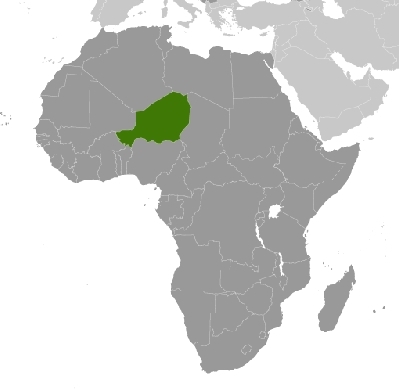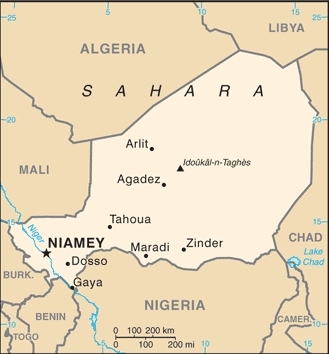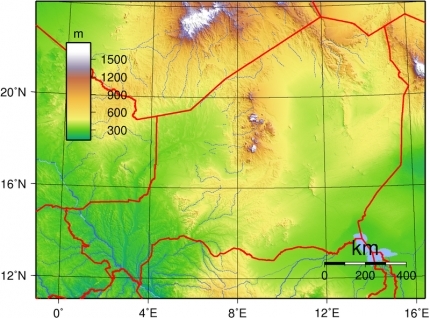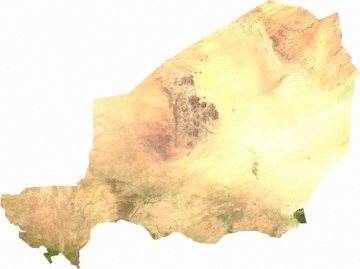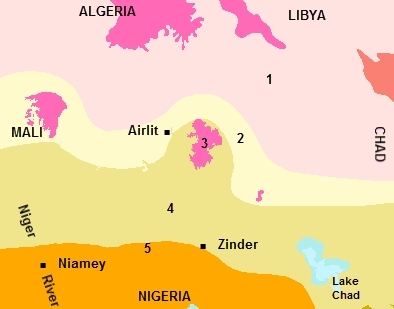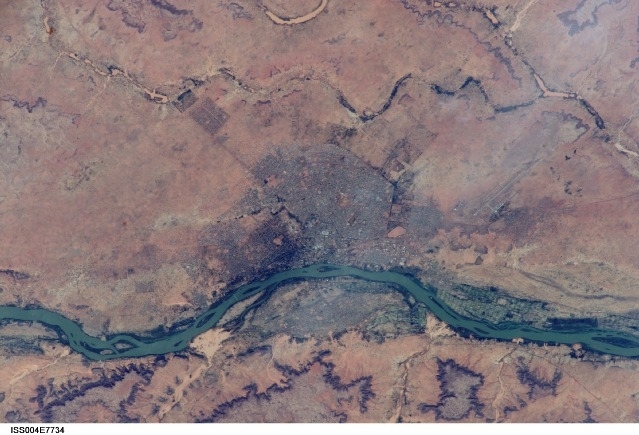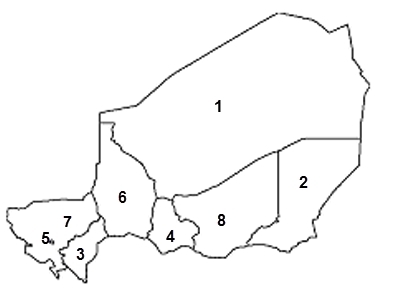Niger
Countries and Regions of the World Collection  Niger is a landlocked country of seventeen million people in western-Africa, southeast of Algeria.
Niger is a landlocked country of seventeen million people in western-Africa, southeast of Algeria.
Niger is one of the hottest countries in the world, Niger is dominated by the Sahara Desert which covers the northern four-fifths of country with desert plains and sand dunes. The southern one-fifth, where the Niger River crosses the country, is savanna, with flat to rolling plains suitable for livestock and limited agriculture.
There are hills in north. Niger is one of the poorest countries in the world with minimal government services and insufficient funds to develop its resource base.
The largely agrarian and subsistence-based economy is frequently disrupted by extended droughts common to the Sahel region of Africa.
Niger's major environmental issues include:
- overgrazing;
- soil erosion;
- deforestation;
- desertification; and,
- wildlife populations (such as elephant, hippopotamus, giraffe, and lion) which are threatened because of poaching and habitat destruction.
Niger is susceptible to recurring droughts.
Niger became independent from France in 1960 and experienced single-party and military rule until 1991, when Gen. Ali Saibou was forced by public pressure to allow multiparty elections, which resulted in a democratic government in 1993.
Political infighting brought the government to a standstill and in 1996 led to a coup by Col. Ibrahim Bare.
In 1999 Bare was killed in a coup by military officers who promptly restored democratic rule and held elections that brought Mamadou Tandja to power in December of that year. Tandja was reelected in 2004.
A predominately Tuareg ethnic group emerged in February 2007, the Nigerien Movement for Justice (MNJ), and attacked several military targets in Niger's northern region throughout 2007 and 2008. Events have since evolved into a fledging insurgency.
Contents
Geography
Location: Western Africa, southeast of Algeria
Geographic Coordinates: 16 00 N, 8 00 E
Area: 1.267 million km2 (1,266,700 km2 land and 300 km2water)
arable land: 11.43%
permanent crops: 0.01%
other: 88.56% (2005)
Land Boundaries: 5,697 km. Border countries: Algeria 956 km, Benin 266 km, Burkina Faso 628 km, Chad 1,175 km, Libya 354 km, Mali 821 km, Nigeria 1,497 km
Coastline: 0 km (landlocked)
Maritime Claims: none (landlocked)
Natural Hazards: recurring droughts
Terrain: Predominately desert plains and sand dunes; flat to rolling plains in south; hills in north. Its lowest point is the Niger River (200 metres) and its highest point is Mont Bagzane (2,022 metres)
Climate: Desert; mostly hot, dry, dusty; tropical in extreme south
|
Topography of Niger. Source: Wikimedia Commons |
Satellite view of Niger. Source: The Map Library |
Ecology and Biodiversity
|
2. South Saharan steppe and woodlands 3. West Saharan montane xeric woodlands See also: People and SocietyPopulation: 17,078,839 (July 2012 est.) |
Source: World Wildlife Fund |
The largest ethnic groups in Niger are the Hausa, who also constitute the major ethnic group in northern Nigeria, and the Djerma-Songhai, who also are found in parts of Mali. Both groups, along with the Gourmantche, are sedentary farmers who live in the arable, southern tier of the country. Other Nigeriens are nomadic or semi-nomadic livestock-raising peoples--Fulani, Tuareg, Kanuri, Arabs, and Toubou. With rapidly growing populations and the consequent competition for meager natural resources, lifestyles of agriculturalists and livestock herders are increasingly threatened.
Niger's high infant mortality rate is comparable to levels recorded in neighboring countries. However, the child mortality rate (deaths among children under age of 5) is particularly high (198 per 1,000 in 2010) due to generally poor health conditions and inadequate nutrition for most of the country's children. Niger's fertility rate (7.8 births per woman), is among the highest in the world, and is far higher than the sub-Saharan African average of 5.4. Two-thirds (66.7%) of the Nigerien population is under age 25. The primary school net enrollment rate is 49% for boys and 31% for girls. Additional education occurs through thousands of Koranic schools.
Ethnic groups: Haoussa 55.4%, Djerma Sonrai 21%, Tuareg 9.3%, Peuhl 8.5%, Kanouri Manga 4.7%, other 1.2% (2001 census)
Age Structure:
0-14 years: 49.6% (male 4,129,164/female 4,045,412)
15-64 years: 48% (male 3,944,586/female 3,964,249)
65 years and over: 2.3% (male 170,741/female 214,734) (2011 est.)
Population Growth Rate: 3.63% (2012 est.)
Birth Rate: 50.06 births/1,000 population (2012 est.)
Death Rate: 13.76 deaths/1,000 population (July 2012 est.)
Net Migration Rate: 0 migrant(s)/1,000 population (2012 est.)
Life Expectancy at Birth: 53.8 years
male: 52.51 years
female: 55.13 years (2012 est.)
Total Fertility Rate: 7.52 children born/woman (2012 est.) - The highest fertility rate in the world.
Languages: French (official), Hausa, Djerma
Literacy (2005 est.): 28.7% (male: 42.9% - female: 15.1%)
Urbanization: 17% of total population (2010) growing at a 4.7% annual rate of change (2010-15 est.)
History
Considerable evidence indicates that about 600,000 years ago, humans inhabited what has since become the desolate Sahara of northern Niger. Long before the arrival of French influence and control in the area, Niger was an important economic crossroads and the empires of Songhai, Mali, Gao, Kanem, and Bornu, as well as a number of Hausa states, claimed control over portions of the area.
During recent centuries, the nomadic Tuareg formed large confederations, pushed southward, and, siding with various Hausa states, clashed with the Fulani Empire of Sokoto, which had gained control of much of the Hausa territory in the late 18th century.
In the 19th century, contact with the West began when the first European explorers--notably Mungo Park (British) and Heinrich Barth (German)--explored the area searching for the mouth of the Niger River. Although French efforts at pacification began before 1900, dissident ethnic groups, especially the desert Tuareg, were not subdued until 1922, when Niger became a French colony.
Niger's colonial history and development parallel that of other French West African territories. France administered its West African colonies through a governor-general in Dakar, Senegal, and governors in the individual territories, including Niger. In addition to conferring French citizenship on the inhabitants of the territories, the 1946 French constitution provided for decentralization of power and limited participation in political life for local advisory assemblies.
A further revision in the organization of overseas territories occurred with the passage of the Overseas Reform Act (Loi Cadre) of July 23, 1956, followed by reorganization measures enacted by the French Parliament early in 1957. In addition to removing voting inequalities, these laws provided for creation of governmental organs, assuring individual territories a large measure of self-government. After the establishment of the Fifth French Republic on December 4, 1958, Niger became an autonomous state within the French Community. Following full independence on August 3, 1960, however, membership was allowed to lapse.
For its first 14 years as an independent state, Niger was run by a single-party civilian regime under the presidency of Hamani Diori. In 1974, a combination of devastating drought and accusations of rampant corruption resulted in a military coup that overthrew the Diori regime. Lieutenant Colonel Seyni Kountche and a small group of military ruled the country until Kountche's death in 1987. He was succeeded by his chief of staff, Brigadier General Ali Saibou, who released political prisoners, liberalized some of Niger's laws and policies, and promulgated a new constitution. However, President Saibou's efforts to control political reforms failed in the face of union and student demands to institute a multi-party democratic system. The Saibou regime agreed to these demands by the end of 1990. New political parties and civic associations sprang up, and a national conference was convened in July 1991 to prepare the way for the adoption of a new constitution and the holding of free and fair elections. The debate was often contentious and accusatory, but under the leadership of Prof. Andre Salifou, the conference developed consensus on the modalities of a transition government. A transition government was installed in November 1991 to manage the affairs of state until the institutions of the Third Republic were put into place in April 1993 following the election of a ruling coalition. While the economy deteriorated over the course of the transition, certain accomplishments stand out, including the successful conduct of a constitutional referendum; the adoption of key legislation such as the electoral and rural codes; and the holding of several free, fair, and nonviolent nationwide elections. Freedom of the press flourished with the appearance of several new independent newspapers.
In the culmination of an initiative started under the 1991 national conference, the government signed peace accords in April 1995 with all Tuareg and Toubou groups that had been in rebellion since 1990. These groups had claimed that they had lacked attention and resources from the central government. The government agreed to absorb some former rebels into the military and, with French assistance, to help others return to civilian life.
Rivalries within the coalition elected in 1993 led to governmental paralysis, which provided Col. Ibrahim Bare Mainassara a rationale to overthrow the Third Republic and its President, Mahamane Ousmane, in January 1996. While leading a military authority that ran the government (Conseil de Salut National) during a 6-month transition period, Bare enlisted specialists to draft a new constitution for a Fourth Republic announced in May 1996. After dissolving the national electoral committee, Bare organized and won a flawed presidential election in July 1996 and his party won 90% of parliament seats in a flawed legislative election in November 1996. When his efforts to justify his coup and subsequent questionable elections failed to convince donors to restore multilateral and bilateral economic assistance, a desperate Bare ignored an international embargo against Libya and sought Libyan funds to aid Niger's economy. In repeated violations of basic civil liberties by the regime, opposition leaders were imprisoned; journalists often arrested, beaten, and deported by an unofficial militia composed of police and military; and independent media offices were looted and burned with impunity.
In April 1999, Bare was overthrown and assassinated in a coup led by Maj. Daouda Mallam Wanke, who established the transitional National Reconciliation Council to oversee the drafting of a constitution for a Fifth Republic with a French-style semi-presidential system. In elections that international observers found to be generally free and fair, the Nigerien electorate approved the new constitution in July 1999 and held legislative and presidential elections in October and November 1999. Mamadou Tandja won the presidency, heading a coalition of the National Movement for the Development of Society (MNSD) and the Democratic and Social Convention (CDS).
In July 2004, Niger held nationwide municipal elections as part of its decentralization process. Some 3,700 people were elected to new local governmental positions in 265 newly established communes. Although the ruling MNSD party won more positions than any other political party, opposition parties made significant gains.
In November and December 2004, Niger held presidential and legislative elections. Mamadou Tandja was elected to his second 5-year presidential term with 65% of the vote in an election that international observers called generally free and fair. This was the first presidential election with a democratically elected incumbent and was a test of Niger's young democracy. In the 2004 legislative elections, the ruling MNSD, the CDS, the Rally for Social Democracy (RSD), the Rally for Democracy and Progress (RDP), the Nigerien Alliance for Democracy and Progress (ANDP), and the Social Party for Nigerien Democracy (PSDN) coalition, all of which backed Tandja, won 88 of the 113 seats in the National Assembly.
In February 2007, a previously unknown rebel group, the Movement of Nigeriens for Justice (MNJ), emerged as a formidable threat to peace in the north of Niger. The predominantly Tuareg group issued a number of demands, mainly related to development in the north. It attacked military and other facilities and laid landmines in the north. The resulting insecurity devastated Niger's tourist industry and deterred investment in mining and oil. The government labeled the MNJ members criminals and traffickers, and refused to negotiate with the group until it disarmed.
Since then, the Government of Niger, with U.S. encouragement that included a conflict-negotiation workshop facilitated by the U.S. Institute of Peace, pursued several rounds of peace talks with the MNJ and other rebel groups, resulting in a de facto ceasefire, weapons handovers, and an executive order providing amnesty to rebels and those who supported them, including members of the Nigerien Armed Forces. The Government of Niger has made considerable progress in bringing peace and stability to the region; following the November 2009 lifting of the state of alert for Agadez Region, tourists were able to travel to and within the urban parts of Agadez city.
President Tandja, who should have left office in December 2009 after having served two consecutive 5-year terms, manipulated political events to prolong his rule. To do so, in 2009 he mounted a campaign to replace the 1999 constitution, which he could not amend, with one that would eliminate term limits and consolidate presidential authority, a clear violation of the 1999 constitution. Overriding the formal ruling of the Constitutional Court and the views of pro-democracy civil society and political parties, Tandja forced through a costly referendum and instituted the Sixth Republic. An Economic Community of West African States (ECOWAS) mediator sent to help bring an end to the political crisis was unable to break the impasse.
On February 18, 2010, military forces stormed the presidential compound and took members of the president’s senior staff and ministers into custody. There were few casualties, and by that evening leaders of the military junta who led the coup against Tandja announced on Niger’s public television station that the government would be led by a new entity called the Supreme Council for the Restoration of Democracy (CSRD).
In April, the president of the CSRD and leader of the coup, Major Salou Djibo, chaired a national ceremony for the installation of the National Consultative Council (NCC), charged with providing guidance on all questions of national interest and producing versions of the “fundamental documents,” notably a draft constitution, a draft electoral code, a draft political parties’ charter, draft statutes for the opposition, and a draft law on public access to information. On May 6, 2010 the CSRD accepted the NCC’s proposal for a 12-month transition to democracy, retroactive to February 18, 2010.
Government
Government Type: Republic
On September 2, 2010, CSRD president Djibo approved the draft constitution submitted by the NCC; on October 1, he signed a decree calling for a constitutional referendum on October 31. The referendum passed with over 90% approval. Local elections were held on January 11, 2011, and first-round presidential elections in conjunction with parliamentary elections on January 31. The second-round presidential elections pitted Mahamadou Issoufou of the Nigerien Party for Democracy and Socialism (PNDS) against Seini Oumarou of the MNSD. On March 12, Issoufou won the presidency with about 58% of the vote. He was inaugurated on April 7, 2011 and named Brigi Rafini as Prime Minister.
Capital: Niamey - 1.004 million (2009)
Astronaut photgraph of Niamey and the Niger river taken February 6, 2002. Source: NASA
|
Administrative Divisions: 8 regions (regions, singular - region) includes 1 capital district* (communite urbaine);
The chief administrators in each of Niger’s eight regions (governors) and 36 districts or departments (prefects) are appointed by the Government of Niger and function primarily as the local agents of the central authorities. Independence Date: 3 August 1960 (from France) Legal System: based on French civil law system and customary law; has not accepted compulsory ICJ jurisdiction. Niger's independent judicial system is composed of four higher courts--the Court of Appeals, the Supreme Court, the High Court of Justice, and the Constitutional Court. In January 2007, the National Assembly voted to divide the Supreme Court into three high courts--an Administrative Court, a Supreme Court of Justice, and an Audit Court. |
Source: The Map Library |
Suffrage: 18 years of age; universal
International Environmental Agreements
Niger is party to international agreements on: Biodiversity, Climate Change, Climate Change-Kyoto Protocol, Desertification, Endangered Species, Environmental Modification, Hazardous Wastes, Ozone Layer Protection, and Wetlands. It has signed, but not ratified the international agreement known as the Law of the Sea.
Water
Total Renewable Water Resources: 33.7 cu km (2003)
Freshwater Withdrawal: Total: 2.18 cu km/yr (4% domestic, 0% industrial, 95% agricultural). Per capita: 156 cu m/yr (2000)
Access to improved sources of drinking water: 48% of population
Access to improved sanitation facilities: 9% of population
Agriculture
Agriculture contributes about 40% of GDP and provides livelihood for about 80% of the population. Traditional subsistence farming, herding, small trading, seasonal migration, and informal markets dominate an economy that generates few formal sector jobs. Fourteen percent of Niger's GDP is generated by livestock production--camels, goats, sheep, and cattle. Fifteen percent of Niger's land is arable, found mainly along its southern border with Nigeria. Rainfall varies, and when insufficient, Niger has difficulty feeding its population and must rely on grain purchases and food aid to meet food requirements. Niger’s economic growth rates are closely linked to rainfall and fluctuate widely in connection with agricultural output.
Agricultural Products: cowpeas, cotton, peanuts, millet, sorghum, cassava (tapioca), rice; cattle, sheep, goats, camels, donkeys, horses, poultry
Irrigated Land: 730 sq km (2003)
Resources
In 2009, 64% of export earnings were from uranium, 20.5% were from livestock, and about 6% from other agriculture, most notably onions. Actual livestock exports far exceed official statistics, which often do not include large herds of animals that are simply walked across the border to markets in Nigeria. Some hides and skins are exported, and some are used for handicrafts.
Niger has exploitable deposits of gold in the region between the Niger River and the border with Burkina Faso. Niger’s sole commercial gold mine, Samira Hill, opened in 2004 under a joint venture known as SML between a Canadian company--Societe SEMAFO Inc. (80%) and the Government of Niger (20%). Gold prices have been very strong in recent years, but income from the Samira mine was limited until April 2009, because a percentage of the mine’s production had been committed to forward sales at a lower price when the mine was initially financed. Now that this commitment has been fulfilled, Samira’s production is sold at market price, and SML was recently awarded an additional concession that will extend the life of the mine.
Niger also has oil potential. China National Petroleum Company is exploiting the Agadem block and a refinery north of Zinder, which was expected to be operational by late July 2011. The parastatal SONICHAR (Societe Nigerienne de Charbon) in Tchirozerine (north of Agadez) extracts coal from an open pit and fuels an electricity-generating plant that supplies energy to the uranium mines. There are additional low-quality coal deposits southwest of the current mines. Substantial deposits of phosphates, iron, limestone, and gypsum also have been found in Niger.
Natural Resources: uranium, coal, iron ore, tin, phosphates, gold, molybdenum, gypsum, salt, petroleum.
Land Use:
arable land: 11.43%
permanent crops: 0.01%
other: 88.56% (2005)
Energy
| Energy in Niger | |||||
| Production | Consumption | Exports | Imports | Reserves | |
| Electricity | 200 million kWh (2008 est.) |
626 million kWh (2008 est.) |
0 kWh (2009 est.) |
440 million kWh (2008 est.) |
|
| Oil | 0 bbl/day (2010 est.) |
6,000 bbl/day (2010 est.) |
0 bbl/day (2009 est.) |
5,443 bbl/day (2009 est.) |
0 bbl (1 January 2011 est.) |
| Natural Gas | 0 cu m (2009 est.) |
0 cu m (2009 est.) |
0 cu m (2009 est.) |
0 cu m (2009 est.) |
0 cu m (1 January 2011 est.) |
| Source: CIA Factbook | |||||
Economy
Niger is one of the world’s top uranium exporters, but 80% of the population is employed in subsistence agriculture. The country has consistently ranked at the bottom of the UN Human Development Index, rising from the bottom of the index in 2009 to number 167 of 169 countries in 2010. Traditional subsistence farming, herding, small trading, seasonal migration, and informal markets dominate an economy that generates few formal sector jobs. Fourteen percent of Niger's GDP is generated by livestock production--camels, goats, sheep, and cattle. Fifteen percent of Niger's land is arable, found mainly along its southern border with Nigeria. Rainfall varies, and when insufficient, Niger has difficulty feeding its population and must rely on grain purchases and food aid to meet food requirements. Niger’s economic growth rates are closely linked to rainfall and fluctuate widely in connection with agricultural output. In 2010, the economy showed strong growth (8% growth rate in real GDP, up from -1.2% in the drought year of 2009).
In 2009, 64% of export earnings were from uranium, 20.5% were from livestock, and about 6% from other agriculture, most notably onions. Actual livestock exports far exceed official statistics, which often do not include large herds of animals that are simply walked across the border to markets in Nigeria. Some hides and skins are exported, and some are used for handicrafts.
Niger has exploitable deposits of gold in the region between the Niger River and the border with Burkina Faso. Niger’s sole commercial gold mine, Samira Hill, opened in 2004 under a joint venture known as SML between a Canadian company--Societe SEMAFO Inc. (80%) and the Government of Niger (20%). Gold prices have been very strong in recent years, but income from the Samira mine was limited until April 2009, because a percentage of the mine’s production had been committed to forward sales at a lower price when the mine was initially financed. Now that this commitment has been fulfilled, Samira’s production is sold at market price, and SML was recently awarded an additional concession that will extend the life of the mine.
Niger also has oil potential. China National Petroleum Company is exploiting the Agadem block and a refinery north of Zinder, which was expected to be operational by late July 2011. The parastatal SONICHAR (Societe Nigerienne de Charbon) in Tchirozerine (north of Agadez) extracts coal from an open pit and fuels an electricity-generating plant that supplies energy to the uranium mines. There are additional low-quality coal deposits southwest of the current mines. Substantial deposits of phosphates, iron, limestone, and gypsum also have been found in Niger.
The new government actively seeks foreign private investment and considers it key to restoring economic growth and development. With the assistance of the United Nations Development Program (UNDP) and international financial institutions, it plans a concerted effort to revitalize the private sector. Niger has attracted significant investment over the years, in uranium, the petroleum sector, cellular communications, and, most recently, in a dam and a cement factory, but poor legal and physical infrastructure still hamper investment. To date, there are seven major active Internet service providers operating in Niger--Sonitel, Afripa, Moov Niger, Orange Niger, ConnecteO, X.com, and Liptinfor. They are fairly independent and they are not required to use the state-owned infrastructure. Sonitel no longer has a monopoly in the telecommunications sector.
Niger shares a common currency, the CFA franc, and a common central bank, the Central Bank of West African States (BCEAO), with seven other members of the West African Monetary Union. The Treasury of the Government of France supplements the BCEAO's international reserves in order to maintain a fixed rate of 656 CFA to the Euro. The CFA is freely convertible to Euro or dollars, but there are restrictions on the amount of CFA that can be converted. Amounts greater than CFA 800,000 (approximately U.S. $1,800 or Euro 1,200) require approval from the Ministry of Finance. (Travelers need only show a passport and a plane ticket to receive approval.)
Economic Reform
In December 2000, Niger qualified for enhanced debt relief under the International Monetary Fund (IMF) program for Heavily Indebted Poor Countries (HIPC) and concluded an agreement with the Fund on a Poverty Reduction and Growth Facility (PRGF). Niger reached decision point in January 2001 and completion point in 2004. Debt service as a percentage of government revenue was slashed from nearly 44% in 1999 to 10.9% in 2003 and will average 4.3% during 2010-2019. The debt relief cut debt service as a percentage of export revenue from more than 23% to 8.4% in 2003, and decreases it to about 5% in later years. In 2005, the IMF canceled all Niger's debt to it (approximately $111 million) incurred before January 2005. In 2006, the African Development Fund canceled $193 million in debt for Niger. The World Bank announced that approximately $745 million in debt relief for Niger would be phased in over the next 37 years.
Foreign Aid
The most important donors in Niger are France, the European Union, the World Bank, the IMF, and UN agencies--UNDP, UNICEF, FAO, WFP, and UNFPA. Other donors include the United States, Belgium, Germany, Switzerland, Japan, China, Italy, Libya, Egypt, Morocco, Iran, Denmark, Canada, and Saudi Arabia. The U.S. Agency for International Development (USAID) has a field office that operates within the U.S. Embassy in Niamey. The United States has provided approximately $65 million to Niger's development during FY 2011 (including $15 million in non-emergency P.L. 480 food assistance; $18 million in emergency food programs; and $32 million in agriculture, nutrition, community health, peace and security, election support, and democracy and governance). These development and emergency programs are carried out by more than 20 U.S. implementing partners (private voluntary organizations and contractors); a limited amount of this support is made available to UN agencies such as WFP and UNICEF. Since inauguration of the elected government in April 2011, the United States, with the majority of the donor community, has started to reengage in several key sectors. Foreign aid represents 8.3% of Niger's GDP and over 40% of government revenues.
The government has announced an expansionary budget for 2012 with anticipated revenue increases from uranium, oil production, and donor aid, and it has made efforts to secure a new three-year extended credit facility with the IMF following the one that completed in 2011. Food security remains a problem in the north of the country, exacerbated by the return of Libyan migrants.
GDP (Purchasing Power Parity): $11.93 billion (2011 est.)
GDP (Official Exchange Rate): $6.5 billion (2011 est.)
GDP- per capita (PPP): $800 (2011 est.)
GDP- composition by sector:
agriculture: 39%
industry: 16%services: 45% (2011 est.)
Population Below Poverty Line: 63% (1993 est.)
Industries: uranium mining, cement, brick, soap, textiles, food processing, chemicals, slaughterhouses
Currency: Niger shares a common currency, the CFA franc, and a common central bank, the Central Bank of West African States (BCEAO), with seven other members of the West African Monetary Union.

